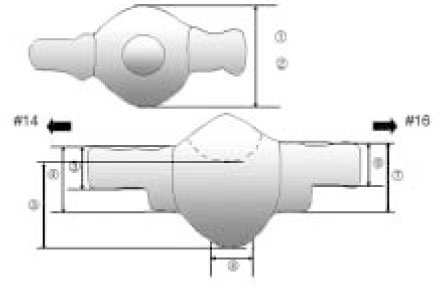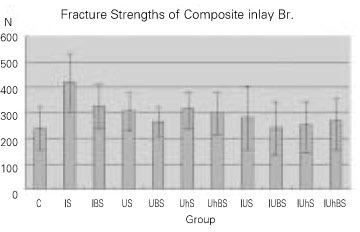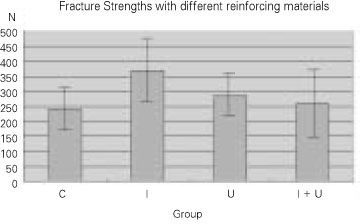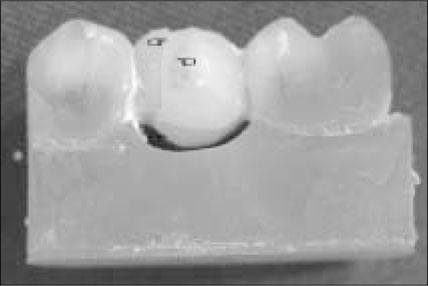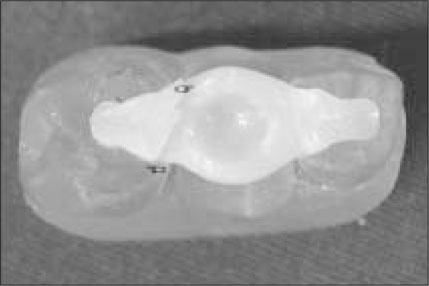J Korean Acad Conserv Dent.
2007 Mar;32(2):111-120. 10.5395/JKACD.2007.32.2.111.
The effect of reinforcing methods on fracture strength of composite inlay bridge
- Affiliations
-
- 1Department of Conservative Dentistry, Division of Dentistry, Graduate of Kyung Hee University, Korea. kkyu@khu.ac.kr
- KMID: 2175844
- DOI: http://doi.org/10.5395/JKACD.2007.32.2.111
Abstract
- The purpose of this study is to evaluate the effects of surface treatment and composition of reinforcement material on fracture strength of fiber reinforced composite inlay bridges. The materials used for this study were I-beam, U-beam TESCERA ATL system and ONE STEP(Bisco, IL, USA). Two kinds of surface treatments were used; the silane and the sandblast. The specimens were divided into 11 groups through the composition of reinforcing materials and the surface treatments. On the dentiform, supposing the missing of Maxillary second pre-molar and indirect composite inlay bridge cavities on adjacent first pre-molar disto-occlusal cavity, first molar mesio-occlusal cavity was prepared with conventional high-speed inlay bur.The reinforcing materials were placed on the proximal box space and build up the composite inlay bridge consequently. After the curing, specimen was set on the testing die with ZPC. Flexural force was applied with universal testing machine (EZ-tester; Shimadzu, Japan). at a cross-head speed of 1 mm/min until initial crack occurred. The data wasanalyzed using one-way ANOVA/Scheffes' post-hoc test at 95% significance level. Groups using I-beam showed the highest fracture strengths (p < 0.05) and there were no significant differences between each surface treatment (p > 0.05). Most of the specimens in groups that used reinforcing material showed delamination. 1. The use of I-beam represented highest fracture strengths (p < 0.05). 2. In groups only using silane as a surface treatment showed highest fracture strength, but there were no significant differences between other surface treatments (p > 0.05). 3. The reinforcing materials affect the fracture strength and pattern of composites inlay bridge. 4. The holes at the U-beam did not increase the fracture strength of composites inlay bridge.
Keyword
Figure
Cited by 1 articles
-
Esthetic rehabilitation of single anterior edentulous space using fiber-reinforced composite
Hyeon Kim, Min-Ju Song, Su-Jung Shin, Yoon Lee, Jeong-Won Park
Restor Dent Endod. 2014;39(3):220-225. doi: 10.5395/rde.2014.39.3.220.
Reference
-
1. Ellakwa AE, Shortall AC, Shehata MK, Marquis PM. The influence of fibre placement and position on the efficiency of reinforcement of fibre reinforced composite bridgework. J Oral Rehabil. 2001. 28(8):785–791.
Article2. Dyer SR, Lassila LV, Jokinen M, Vallittu PK. Effect of fiber position and orientation on fracture load of fiber-reinforced composite. Dent Mater. 2004. 20(10):947–955.
Article3. Lassila LV, Vallittu PK. The effect of fiber position and polymerization condition on the flextural properties of fiber-reinforced composite. J Contemp Dent Pract. 2004. 5(2):14–26.
Article4. Debnath S, Wunder SL, McCool JI, Baran GR. Silane treatment effects on glass/resin interfacial shear strengths. Dent Mater. 2003. 19(5):441–448.
Article5. Ozcan M, Breuklander MH, Vallittu PK. The effect of box preparation on the strength of glass fiber-reinforced composite inlay-retained fixed partial dentures. J Prosthet Dent. 2005. 93(4):337–345.
Article6. Göhring TN, Roos M. Inlay-fixed partial dentures adhesively retained and reinforced by glass fibers: clinical and scanning electron microscopy anlysis after five years. Eur J Oral Sci. 2005. 113(1):60–69.
Article7. Sahafi A, Peuzfeldt A, Asmussen E, Gotfredsen K. Bond strength of resin cement to dentin and to surface-treated posts of titanium alloy, glass fiber, and zirconia. J Adhes Dent. 2003. 5(2):153–162.8. Rosentritt M, Behr M, Handel G. Fixed partial dentures: all-ceramics, fibre-reinforced composites and experimental systems. J Oral Rehabil. 2003. 30(9):873–877.
Article9. Suh BI. New concepts and technology for processing of indirect composites. Compend Contin Educ Dent. 2003. 24(8):40–42.10. Ibbetson R. Clinical consideration for adhesive bridge-work. Dent Update. 2004. 31:254–265.11. Goracci C, Tavares AU, Fabianelli A, Monticelli F, Raffaelli O, Cardoso PC, Tay F, Ferrari M. The adhesion between fiber posts and root canal walls: comparison between microtensile and push-out bond strength measurements. Eur J Oral Sci. 2004. 112(4):353–361.
Article12. Goracci C, Raffaelli O, Monticelli F, Balleri B, Bertieeli E, Ferrari M. The adhesion between prefabricated FRC posts and composite resin cores: microtensile bond strength with and without post-silanization. Dent Mater. 2005. 21(5):437–444.
Article13. Ellakwa AE, Shortall AC, Marquis PM. Influence of different techniques of laboratory construction on the fracture resistance of fiber-reinforced composite (FRC) bridges. J Contemp Dent Pract. 2004. 5(4):1–13.
Article14. Soares CJ, Martins LR, Pfeifer JM, Giannini M. Fracture resistance of teeth restored with indirect-composite and ceramic inlay systems. Quintessence Int. 2004. 35(4):281–286.15. Giordano R. Fiber reinforced composite resin systems. General Dentistry. 2000. 48:244–249.16. Minesaki Y, Suzuki S, Kajihara H, Tanaka T. Effect of reinforcement methods on the resin-bonded fixed partial dentures using a composite denture tooth as a pontic: in vitro evaluation. J Adhes Dent. 2003. 5:225–234.17. Craig WH, Courtney TH. On the tension test as a means of characterizing fiber composite failures mode. J Mater Sci. 1975. 10:1119–1126.
Article18. Edelhoff D, Spiekermann H, Yildirim M. Metal-free inlay-retained fixed partial dentures. Quintessence Int. 2001. 32(4):269–281.19. Zammarieh E. Three unit metal-free inlay bridge. J Dent Technol. 2000. 17(6):21–25.20. Isidor F, Stokholm R. Resin-bonded prostheses for posterior teeth. J Prosthet Dent. 1992. 68(2):239–243.
Article21. Lowe E, Rego NA. Posterior restoration using laboratory-fabricated composite resin. Pract Periodontics Aesthet Dent. 2000. 12(3):279–283.22. Shannon A. Fiber-reinforced composite bridge inlay-toinlay Technique. Dentistry today. 1997. 16(11):48–53.23. Smales RJ, Berekally TL, Webster DA. Predictions of resin-bonded bridge survivals, comparing two statistical models. J Dent. 1993. 21(3):147–149.
Article24. Ziada HM, Benington IC, Orr JF. Photoelastic stress analysis in resin bonded bridge design. Eur J Prosthodont Restor Dent. 1995. 3(5):217–222.25. Markus SJ. An indirect/direct combined approach for reinforced fixed bridge. J N J Dent Assoc. 1994. 65(1):23–26.26. Ali A, Cassidy M, Gilmour A. Resin-bonded bridges: 2 Treatment planning, clinical cases and failures. Dent update. 1992. 19:82–87.27. Creugers NH. Resin-bonded bridges. A status report for the american journal of dentistry. Am J Dent. 1991. 4(5):251–255.28. Terry DA, Touati B. Clinical considerations for aesthetic laboratory-fabricated inlay/onlay restorations: a review. Pract Proced Aesthet Dent. 2001. 13(1):51–58.29. Alex G. Consideration for the successful placement of laboratory-processed, indirect composite restorations. Compend Contin Educ Dent. 2003. 24:43–37.30. Olin PS, Hill EM, Donahue JL. Clinical evaluation of resin-bonded bridges: a retrospective study. Quintessence Int. 1991. 22(11):873–877.31. Blank JT. Scientifically based rationale and protocol for use of modern indirect resin inlays and onlays. J Esthet Dent. 2000. 12(4):195–208.
Article
- Full Text Links
- Actions
-
Cited
- CITED
-
- Close
- Share
- Similar articles
-
- Fiber Reinforced Inlay Adhesion Bridge
- Effect of a desensitizer on dentinal bond strength in cementation of composite resin inlay
- In vitro evaluation of fracture resistance of various thickness fiber-reinforced composite inlay fpd
- A COMPARATIVE STUDY ON THE FRACTURE STRENGTH AND MARGINAL FITNESS OF FIBER-REINFORCED COMPOSITE BRIDGE
- Fracture strength between different connector designs of zirconia core for posterior fixed partial dentures manufactured with CAD/CAM system


